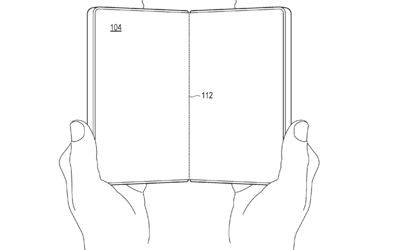Microsoft is reportedly exploring a return to the foldable smartphone market after the discontinuation of its Surface Duo line. A recent patent application suggests the tech giant is developing a new foldable device with a unique hinge mechanism.

The patent, filed on February 29th with the United States Patent and Trademark Office, details a foldable smartphone concept featuring a single hinge technology dubbed the "spine cover plate."
The design appears to be a "book-style" foldable, akin to the Samsung Galaxy Z Fold. The core innovation lies in the spine cover plate, designed to shield and reinforce the device's single hinge system.
The key difference between conventional hinges and Microsoft's design is the automatic adjustment of the spine cover. This aims to eliminate gaps around the hinge during opening and closing, providing enhanced protection against dust and water ingress. While Samsung's current foldable devices boast an IPX8 rating for water resistance, Microsoft's approach could offer improved durability.
Furthermore, the patent suggests the new hinge mechanism could minimize the visibility of the hinge crease, a common concern with foldable devices.
Microsoft also highlights techniques to reduce the overall thickness of the foldable smartphone. The spine cover plate can retract towards the central spine when the device is folded, resulting in a slimmer profile.
"By retracting the spine cover plate toward the central spine as the first display-supporting frame and the second display-supporting frame are rotated into a face-to-face orientation, the width of the folded computing device is reduced, thereby enabling easier and more comfortable handling of the device, such as with one hand," the patent states.
The smartphone industry is actively seeking solutions to eliminate the crease in foldable displays. While some manufacturers have implemented water-drop folding mechanisms to mitigate the issue, a truly crease-free foldable remains elusive. The durability of foldable devices, with their numerous moving parts, is also a significant consideration.
Adding another movable component, such as the spine cover plate, to the foldable mechanism raises questions about practicality. Despite the potential benefits and enhanced durability outlined in the patent application, the added complexity could introduce new challenges.
Newer articles
Older articles
 Smith Eyes Grenada Test Return After Injury Recovery
Smith Eyes Grenada Test Return After Injury Recovery
 Google Maps Boosts Navigation Precision with Fused Orientation Provider Update
Google Maps Boosts Navigation Precision with Fused Orientation Provider Update
 Earth Sciences Minister Rijiju Expresses Frustration Over Atos Supercomputer Delay, Jeopardizing Weather Forecast Upgrades
Earth Sciences Minister Rijiju Expresses Frustration Over Atos Supercomputer Delay, Jeopardizing Weather Forecast Upgrades
 Washington Freedom Snatch Last-Ball Win Over Knight Riders in MLC Thriller; Playoff Hopes Soar
Washington Freedom Snatch Last-Ball Win Over Knight Riders in MLC Thriller; Playoff Hopes Soar
 East Africa Rift: Mantle Upwelling Drives Birth of New Ocean, Study Finds
East Africa Rift: Mantle Upwelling Drives Birth of New Ocean, Study Finds
 Colon Cancer: Don't Ignore These 5 Subtle Warning Signs
Colon Cancer: Don't Ignore These 5 Subtle Warning Signs
 Prasidh Krishna Vows to Sharpen Bowling After Costly Leeds Performance
Prasidh Krishna Vows to Sharpen Bowling After Costly Leeds Performance
 Gavaskar Urges India to Replace Thakur with Yadav for Second Test Against England
Gavaskar Urges India to Replace Thakur with Yadav for Second Test Against England
 Rishabh Pant's Unconventional Batting Style Is Revolutionizing Cricket, Says Greg Chappell
Rishabh Pant's Unconventional Batting Style Is Revolutionizing Cricket, Says Greg Chappell
 Vitamin B12 Deficiency: Cardiologist Explains Symptoms, Sources, and Why You're Always Tired
Vitamin B12 Deficiency: Cardiologist Explains Symptoms, Sources, and Why You're Always Tired